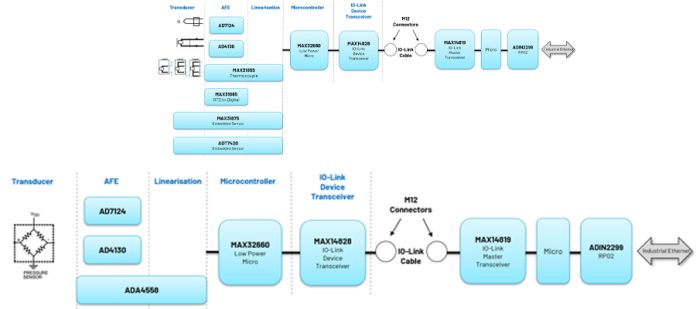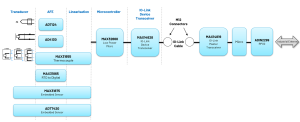By Michael Jackson and Brian Condell
If you’re about to start designing a smart factory sensor, you’ll want to ensure that you can do it as quickly and efficiently as possible while maximizing the number of customers who can use it. This blog presents design ideas for smart factory sensors (temperature and pressure) that can communicate with a PLC regardless of the type of Fieldbus or industrial ethernet network used in a factory process.
Temperature Sensor Transducers – What are the Options?
The most common temperature transducers are 2-,3-, and 4-wire resistance-temperature detectors (RTD), thermocouples, and thermistors, each with relative advantages and disadvantages. If you have the time, there is a vast choice of signal conditioning and data converter ICs for you to build and debug a custom analog front end (AFE),
Is there a Quicker Way to Turn Around my Design?
If time is of the essence, a fully integrated AFE, like the AD7124 or AD4130 sigma-delta ADCs (with integrated PGA), could be a better option. Suppose you’re designing a sensor for an application that requires a thermocouple. In that case, the MAX31855 is a ready-to-use thermocouple-to-digital converter IC (that also performs linearization) and cold-junction compensation. If you’re planning an RTD-based sensor, consider using the MAX31865 RTD-to-Digital IC. Suppose you don’t have time to investigate different transducer types and simply want to design a sensor to quickly and accurately provide a digital temperature reading – in this case, the MAX31875 or the ADT7420 digital temperature sensor ICs are ideal ‘one-stop-shop’ solutions. These integrate a transducer, AFE, and linearizer in a single package that interfaces to a microcontroller via an I2C. Figure 1 illustrates each of these options.
Figure 1 – Alternative temperature sensor signal chains
What about Pressure Sensors?
Strain gauges and load cells are commonly used to generate an electrical signal in pressure sensors, and conveniently, you can use the AD7124 and AD4130 AFEs with these too. Alternatively, you can use the ADA4558 bridge signal conditioner IC to handle linearization if you want to remove this overhead from your microcontroller (Figure 2).
Figure 2 – Alternative pressure sensor signal chains
How have Sensors Traditionally been Connected to Industrial Networks?
Typically, sensors were designed to communicate using a single Fieldbus or Industrial Ethernet protocol. However, this approach requires you to include a network interface IC inside the sensor itself, which adds significantly to its cost while limiting the sensor’s market to those customers using that protocol. Targeting your sensor for another network means a costly and time-consuming redesign of your sensor using a different interface IC. Also, the number and type of diagnostic features vary significantly by network type (with some having none at all), so depending on which protocol your sensor is designed for, it may be difficult for customers to maintain your sensor and identify any performance issues that arise with it, after installation. Therefore, designing your sensor in a way that allows it to work on any industrial network makes more sense as it reduces costs while broadening your market.
How can I make my Sensor ‘Network Agnostic’?
You can do this using IO-Link®, a 3-wire industrial communications standard designed to link sensors and actuators with industrial control networks. In IO-Link applications, a transceiver acts as the physical layer interface to a microcontroller running the data-link layer protocol while supporting digital inputs and outputs (up to 24V). The advantage of using IO-Link is that it carries four different types of transmissions – Process Data, Value Status, Device Data, and Events. These can flag if your sensor malfunctions and allow it to be quickly located. The MAX14828 is a low-power, IO-Link device transceiver which is available in a (4mm x 4mm) 24-pin TQFN package and a (2.5mm x 2.5mm) wafer-level package (WLP) and is specified over the extended -40°C to +125°C temperature range.
How does the IO-Link Device Transceiver Communicate with an Industrial Network?
The IO-Link device transceiver communicates (via a cable) with an IO-Link Master, which connects to an industrial network through a protocol interface IC (like the ADIN2299 for industrial ethernet). The MAX14819A is a low-power, dual-channel, IO-Link master transceiver with sensor/actuator power supply controllers that fully comply with the latest IO-Link and binary input standards and test specifications, IEC 61131-2, IEC 61131-9 SDCI, and IO-Link 1.1.3.










